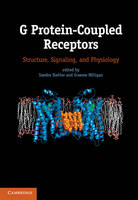
G Protein-Coupled Receptors
Cambridge University Press (Verlag)
978-0-521-11208-6 (ISBN)
Provides a comprehensive overview of recent discoveries and current understandings of G protein-coupled receptors (GPCRs). Recent advances include the first mammalian non-rhodopsin GPCR structures and reconstitution of purified GPCRs into membrane discs for defined studies, novel signaling features including oligomerization, and advances in understanding the complex ligand pharmacology and physiology of GPCRs, in new assay technologies and drug targeting. The authors take time to detail the importance of the pathophysiological function and drug targeting of GPCRs, specifically β-adrenoceptors in cardiovascular and respiratory diseases, metabotropic glutamate receptors in CNS disorders, S1P receptors in the immune system, and Wnt/Frizzled receptors in osteoporosis. This book will be invaluable to researchers and graduate students in academia and industry who are interested in the GPCR field.
Dr Siehler is a Research Investigator at the Novartis Institute for Biomedical Research in Basel, Switzerland. Dr Siehler is a member of the American Society for Pharmacology and Experimental Therapeutics and the British Pharmacological Society. Dr Milligan is Professor of Molecular Pharmacology at the University of Glasgow. He is actively involved in numerous associations, such as the Biochemical Society and British Pharmacological Society. Dr Milligan was awarded the Ariens Award for Pharmacology from the Dutch Pharmacological Society in 2006.
Part I. Advances in GPCR Protein Research: 1. The evolution of the repertoire and structure of G protein-coupled receptors Torsten Schoenberg, Kristin Schroeck, Claudia Staeubert and Andreas Russ; 2. Functional studies of isolated GPCR-G protein complexes in the membrane bilayer of lipoprotein particles Adam J. Kuszak, Xiao Jie Yao, Sören G. F. Rasmussen, Brian K. Kobilka and Roger K. Sunahara; Part II. Oligomerization of GPCRs: 3. GPCR-G protein fusions: use in functional dimerization analysis Graeme Milligan; 4. Time-resolved FRET approaches to study GPCR complexes Jean Phillipe Pin, Damien Maurell, Laetitia Comps-Agrar, Carine Monnier, Marie-Laure Rives, Etienne Doumazane, Philippe Rondard, Thierry Durroux, Laurent Prézeau and Erin Trinquet; 5. Signaling of dopamine receptor homo- and hetero-oligomers Ahmed Hasbi, Brian F. O'Dowd and Susan R. George; 6. Functional consequences of chemokine receptor dimerization Mario Mellado, Carlos Martinez-A. and Jose Miguel Rodgriguez-Frade; Part III. GPCR Signaling Features: 7. G protein functions identified using genetic mouse models Stefan Offermanns; 8. Kinetics of GPCR, G protein and effector activation Peter Hein; 9. RGS-RhoGEFs and other RGS multidomain proteins as effector molecules in GPCR-dependent and GPCR-independent cell signaling José Vázquez-Prado and J. Silvio Gutkind; 10. Adenylyl cyclase isoform-specific signaling of GPCRs Karin F. K. Ejendal, Julie A. Przybyla and Val J. Watts; 11. G protein-independent and β arrestin-dependent GPCR signaling Zhongzhen Nie and Yehia Daaka; 12. Assays to read GPCR modulation and signaling Ralf Heilker and Michael Wolff; Part IV. Ligand Pharmacology of GPCRs: 13. Quantifying allosteric ligand-receptor interactions Ivan Toma Vranesic and Daniel Hoyer; 14. 7TM Receptor functional selectivity Terry Kenakin; Part V. Physiological Functions and Drug Targeting of GPCRs: 15. Beta adrenergic receptors in cardiovascular and respiratory diseases Michele Ciccarelli, J. Kurt Chuprun and Walter J. Koch; 16. Role of metabotropic glutamate receptors in CNS disorders Richard M. O'Connor and John F. Cryan; 17. S1P receptor agonists, a novel generation of immunosuppressants Rosa Lopez Almagro, Gema Tarrason and Nuria Godessart; 18. Wnt/Frizzled receptor signaling in osteoporosis Georges Rawadi.
| Zusatzinfo | 23 Tables, unspecified; 15 Plates, unspecified; 43 Line drawings, unspecified |
|---|---|
| Verlagsort | Cambridge |
| Sprache | englisch |
| Maße | 184 x 260 mm |
| Gewicht | 1100 g |
| Themenwelt | Medizin / Pharmazie ► Medizinische Fachgebiete ► Pharmakologie / Pharmakotherapie |
| Naturwissenschaften ► Biologie ► Biochemie | |
| Naturwissenschaften ► Biologie ► Genetik / Molekularbiologie | |
| ISBN-10 | 0-521-11208-7 / 0521112087 |
| ISBN-13 | 978-0-521-11208-6 / 9780521112086 |
| Zustand | Neuware |
| Haben Sie eine Frage zum Produkt? |
aus dem Bereich


